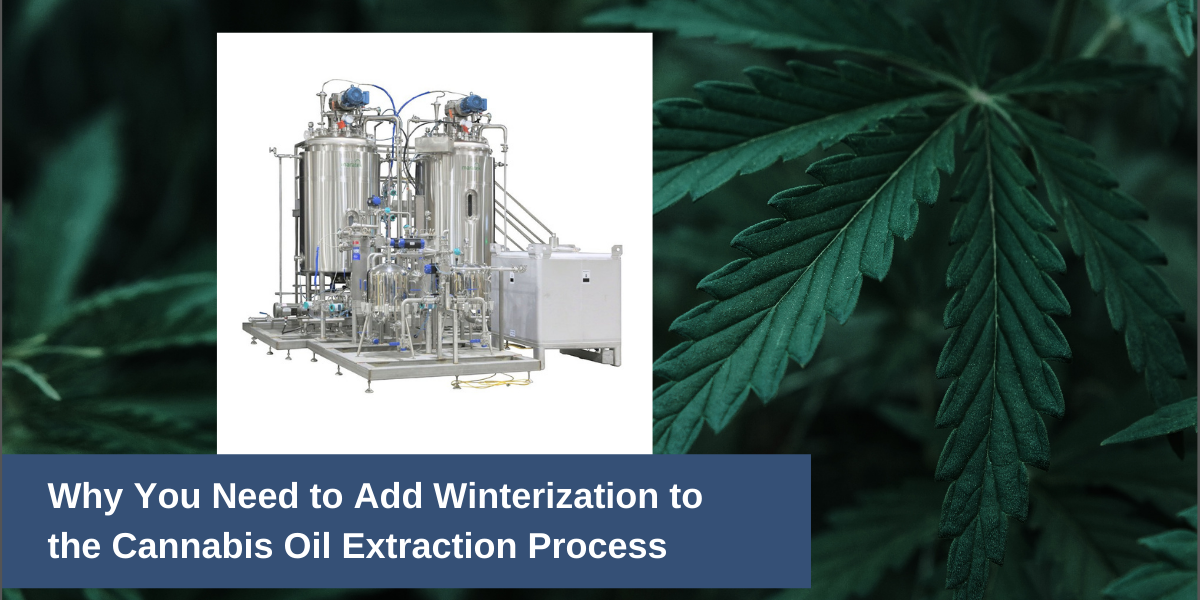Reasons to Add Winterization to the Cannabis Oil Extraction Process

Cannabis is a complex plant containing more than 500 distinct chemicals identified to date, including cannabinoids, terpenes, phenols, flavonoids, fatty acids, pigments, and other miscellaneous compounds.
Typically, the cannabinoid and terpene fractions make up around 20% of the mass of buds. The larger residual fraction may contain useful and desirable compounds, but the cannabinoids and terpenes represent the most valuable components when undergoing the cannabis oil extraction process.
A typical CO2 extraction process produces a crude oil that contains up to 75-80% cannabinoids and terpenes. The remaining portion will consist of co-extracted components from the feedstock that are either highly soluble in CO2 at the given processing parameters; or, have low solubility but are easily accessible and co-extracted with limited mass transfer resistance.
The bulk of these remaining fractions consist of plant fats, waxes, and lipids as described below:
- Plant fats, such as nuts, seeds, avocados, olives, and oils made from plants like sunflowers, olives, soybean, and safflower, tend to have a higher proportion of monounsaturated fatty acids (MUFAs) and polyunsaturated fatty acids (PUFAs), with the exception of coconut, palm kernel, and palm oils.
- Plant waxes are complex mixtures of hydrocarbons, alcohols, aldehydes, ketones, esters, acids, and combinations of these that are deposited in a layer outside the epidermal cells. This complex mixture of lipids probably is synthesized in the epidermal cells of most plants and exuded onto the surface.
- Plant lipids include derivatives of fatty acids, such as triacylglycerides (TAGs) and glycerophospholipids (GPLs), a variety of aromatic and hydrocarbon-like compounds, such as sterols, carotenoids and terpenes, and waxes. The majority of plant lipids act as energy stores. Furthermore, surface lipids such as waxes and cutin provide an impervious barrier on the plant surface to reduce water loss and to provide protection against plant pathogens and toxins.
How winterization will help your cannabis oil extraction process
Winterization leverages the selective solubility of cannabinoids in ethanol at cryogenic temperatures, while rejecting (crashing/crystallizing) the fat/wax/lipid fraction. In this process, the extracted crude oil is typically mixed with a high proof ethanol/water solution in the range of 5:1 to 10:1 and exposed to circa -40°C (or lower) cold temperature to precipitate the undesirable co-extracted solids. The solids are then separated from the liquid through a filtration process, yielding “winterized oil.” Depending on the desired outcome of the process, the oil may be further processed or purified or formulated directly into retail products.
Although winterization is a relatively straightforward and well-defined process, operating at cryogenic temperatures represents a unique set of engineering challenges. The waxes readily redissolve above approximately -20C, and can build up or foul on the walls of process piping, filter media and equipment.
That’s why Maratek has designed its Large Scale Winterizer, which builds upon practical experience in handling scaled winterizing processes. Given the critical function of ethanol solvency in biomass extraction, Maratek leverages its world-class experience in solvent recovery to deliver a true turnkey solution for the cannabis industry.
Want to find out more information? Contact Maratek today. Our team of engineering experts would love to discuss your cannabis oil extraction process needs, as well as provide more information about our turnkey winterization solutions.



